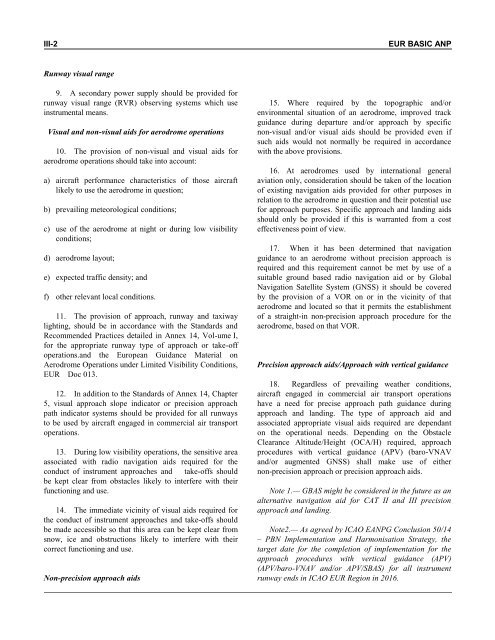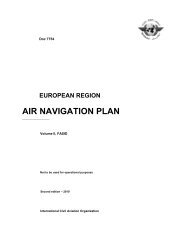7754 Vol 1 Flyleaf - ICAO Public Maps
7754 Vol 1 Flyleaf - ICAO Public Maps
7754 Vol 1 Flyleaf - ICAO Public Maps
Create successful ePaper yourself
Turn your PDF publications into a flip-book with our unique Google optimized e-Paper software.
III-2 EUR BASIC ANP<br />
Runway visual range<br />
9. A secondary power supply should be provided for<br />
runway visual range (RVR) observing systems which use<br />
instrumental means.<br />
Visual and non-visual aids for aerodrome operations<br />
10. The provision of non-visual and visual aids for<br />
aerodrome operations should take into account:<br />
a) aircraft performance characteristics of those aircraft<br />
likely to use the aerodrome in question;<br />
b) prevailing meteorological conditions;<br />
c) use of the aerodrome at night or during low visibility<br />
conditions;<br />
d) aerodrome layout;<br />
e) expected traffic density; and<br />
f) other relevant local conditions.<br />
11. The provision of approach, runway and taxiway<br />
lighting, should be in accordance with the Standards and<br />
Recommended Practices detailed in Annex 14, <strong>Vol</strong>-ume I,<br />
for the appropriate runway type of approach or take-off<br />
operations.and the European Guidance Material on<br />
Aerodrome Operations under Limited Visibility Conditions,<br />
EUR Doc 013.<br />
12. In addition to the Standards of Annex 14, Chapter<br />
5, visual approach slope indicator or precision approach<br />
path indicator systems should be provided for all runways<br />
to be used by aircraft engaged in commercial air transport<br />
operations.<br />
13. During low visibility operations, the sensitive area<br />
associated with radio navigation aids required for the<br />
conduct of instrument approaches and take-offs should<br />
be kept clear from obstacles likely to interfere with their<br />
functioning and use.<br />
14. The immediate vicinity of visual aids required for<br />
the conduct of instrument approaches and take-offs should<br />
be made accessible so that this area can be kept clear from<br />
snow, ice and obstructions likely to interfere with their<br />
correct functioning and use.<br />
Non-precision approach aids<br />
15. Where required by the topographic and/or<br />
environmental situation of an aerodrome, improved track<br />
guidance during departure and/or approach by specific<br />
non-visual and/or visual aids should be provided even if<br />
such aids would not normally be required in accordance<br />
with the above provisions.<br />
16. At aerodromes used by international general<br />
aviation only, consideration should be taken of the location<br />
of existing navigation aids provided for other purposes in<br />
relation to the aerodrome in question and their potential use<br />
for approach purposes. Specific approach and landing aids<br />
should only be provided if this is warranted from a cost<br />
effectiveness point of view.<br />
17. When it has been determined that navigation<br />
guidance to an aerodrome without precision approach is<br />
required and this requirement cannot be met by use of a<br />
suitable ground based radio navigation aid or by Global<br />
Navigation Satellite System (GNSS) it should be covered<br />
by the provision of a VOR on or in the vicinity of that<br />
aerodrome and located so that it permits the establishment<br />
of a straight-in non-precision approach procedure for the<br />
aerodrome, based on that VOR.<br />
Precision approach aids/Approach with vertical guidance<br />
18. Regardless of prevailing weather conditions,<br />
aircraft engaged in commercial air transport operations<br />
have a need for precise approach path guidance during<br />
approach and landing. The type of approach aid and<br />
associated appropriate visual aids required are dependant<br />
on the operational needs. Depending on the Obstacle<br />
Clearance Altitude/Height (OCA/H) required, approach<br />
procedures with vertical guidance (APV) (baro-VNAV<br />
and/or augmented GNSS) shall make use of either<br />
non-precision approach or precision approach aids.<br />
Note 1.— GBAS might be considered in the future as an<br />
alternative navigation aid for CAT II and III precision<br />
approach and landing.<br />
Note2.— As agreed by <strong>ICAO</strong> EANPG Conclusion 50/14<br />
– PBN Implementation and Harmonisation Strategy, the<br />
target date for the completion of implementation for the<br />
approach procedures with vertical guidance (APV)<br />
(APV/baro-VNAV and/or APV/SBAS) for all instrument<br />
runway ends in <strong>ICAO</strong> EUR Region in 2016.














